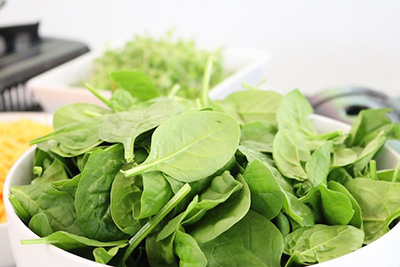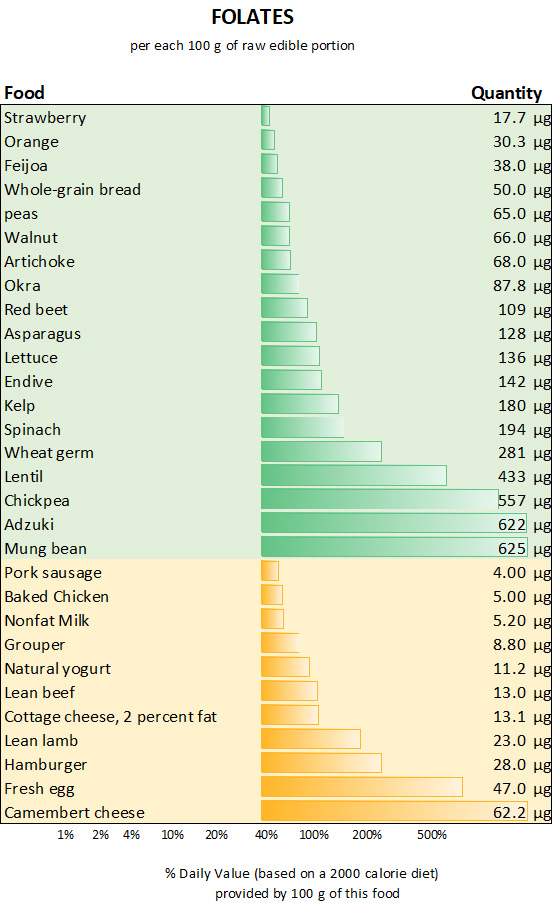Contents
Before we reach the top foods high in folate, let us learn more about this essential vitamin. Folate is also called vitamin B9 or folic acid. It is a group of water-soluble vitamins that play a huge role in many physiological processes within the human body. They are essential for growth, development, and overall well-being. Folates are necessary during rapid cell division and growth, such as in pregnancy and infancy.
Benefits of Folates

Folates are involved in several vital functions in the body, including:
DNA Synthesis and Cell Division: Folates play a vital role in synthesizing and repairing DNA, the genetic material in every cell. They are necessary for proper cell division and growth, especially in rapidly dividing bone marrow, gastrointestinal tract, and developing fetus cells.
Red Blood Cell Formation: Folates are essential for producing red blood cells. They aid in the maturation of the cells and help prevent anemia, a condition depicted by a low sum of red blood cells and insufficient oxygen-carrying capacity.
Neural Tube Development: Adequate folate intake is critical during pregnancy as it helps inhibit neural tube defects, such as spina bifida, in the fetus’s development. Neural tube defects occur when the neural tube forms the brain and spinal cord and does not close properly during early pregnancy.
Heart Health: Some evidence suggests that folates may lower the risk of cardiovascular disease. They help lower homocysteine levels, an amino acid associated with an enhanced risk of heart disease when present in high amounts.
Food Sources of Folates

Folates can be obtained from a variety of food sources. Some of the best sources include:
Green Leafy Vegetables: Leafy green vegetables such as spinach, kale, collard greens, and others are excellent sources of folates. They are also abundant in other necessary nutrients, including vitamins A, C, and K, and minerals like calcium and iron.
Legumes: Beans like black beans, lentils, and chickpeas are an excellent source of fiber and plant-based protein, but they are also a significant source of folate.
Foods fortified with folic acid include grain products like bread, pasta, and breakfast cereals. Foods fortified with folates can be a crucial source of vitamins, especially for people who might struggle to get all the folates they need from natural food sources.
Recommended Intake
Depending on factors including age, gender, and stage of life, different amounts of folates should be consumed daily. The recommended daily allowances (RDAs) for folate are as follows:

- Infants (0-6 months): 65 mcg
- Infants (7-12 months): 80 mcg
- Children (1-3 years): 150 mcg
- Children (4-8 years): 200 mcg
- Children (9-13 years): 300 mcg
- Adolescents (14-18 years): 400 mcg
- Adults (19 years and older): 400 mcg
- Pregnant women: 600 mcg
- Breastfeeding women: 500 mcg
Remembering that women may need more folate during pregnancy to support fetal development is crucial. To ensure patients get enough folic acid, doctors occasionally advise taking supplements.
Folate deficiency can cause several health issues, such as anemia, stunted growth in children and babies, and a higher chance of neural tube defects in unborn children. Folate supplementation can help to prevent these issues. Symptoms of a folate deficiency may include weakness, weariness, trouble concentrating, and irritability.
However, consuming too much folate through pills can conceal a vitamin B12 deficiency, which is more prevalent in older persons. As a result, it’s crucial to see a healthcare provider before beginning any supplements.
By consuming a varied diet that includes foods high in folate, including leafy green vegetables, legumes, and fortified goods, people can meet their folate needs and improve their well-being. Never forget that balance and moderation are essential when it comes to nutrition.
Best Foods High in Folate

Scientific Information
Chemical Composition: The name folate describes folic acid and its salts (folates). Some researchers include all these substances, which possess the same physiological properties, under folacin.
Sources: Legumes are the primary source, followed by green leafy vegetables (spinach, lettuce). Nuts, milk, fish, and meat are poor in folate.
Units of measurement: Micrograms (millionths of a gram), represented by the symbol µg (1 mg = 1000 µg).
Function: Folates are essential for synthesizing DNA (deoxyribonucleic acid) and RNA (ribonucleic acid), which comprise life’s biochemical base. Folates are also involved in producing hemoglobin and many other physiological processes.
Deficiency symptoms: A particular type of anemia, called megaloblastic or macrocytic anemia (few, giant red blood cells); glossitis (tongue inflammation); mental deterioration; congenital malformations of the fetal nervous system.
Increased need: In these cases, it is recommended that folates intake be double the RDA, or to about 400 µg:
- Growth periods: Infancy and adolescence.
- When taking oral contraceptives (these may interfere with the absorption of folates).
- Pregnancy (to avoid fetal malformations).
- Persons at high risk of cardiac disease (to lower the heart attack risk).
- Anemia in general and macrocytic anemia in particular.
- Intestinal parasitosis.
- Regular alcohol consumption blocks the absorption and assimilation of folates; intake of certain medications, such as anti-epileptics and chemotherapeutic drugs used to combat cancer, which counteracts folates.
Loss during the processing of foods: Folates are pretty unstable and are easily destroyed by heat and light.
- Cooking and canning: 50 percent to 95 percent of folates are lost.
- Storage: Vegetables lose 50 percent to 70 percent of their folates at room temperature. When refrigerated, however, folates are little affected.
REFERENCES
- George D. Pamplona-Roger, M.D. “Encyclopedia of Foods and Their Healing Power.” George D. Pamplona-Roger, M.D. Encyclopedia of Foods and Their Healing Power. Trans. Annette Melgosa. Vol. 1. Chai Wan: Editorial Safeliz, 2005. 394. Print. [foods high in folate]
- National Institutes of Health (NIH) Office of Dietary Supplements: https://ods.od.nih.gov/factsheets/Folate-HealthProfessional
- Harvard T.H. Chan School of Public Health: https://www.hsph.harvard.edu/nutritionsource/folic-acid
- U.S. Department of Agriculture (USDA) FoodData Central: https://fdc.nal.usda.gov
Last update on 2025-06-04 / Affiliate links / Images from Amazon Product Advertising API





